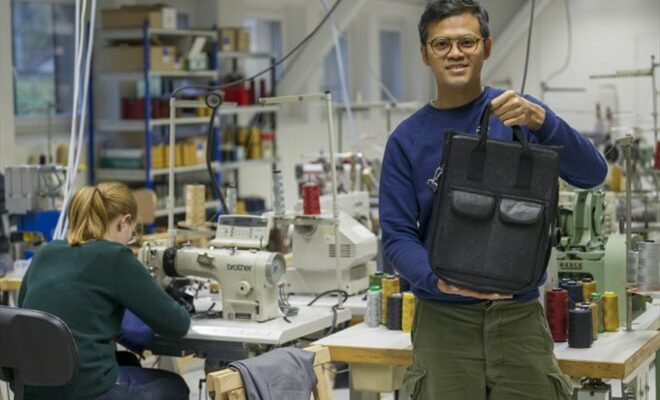Davy Dao, creator of the Dao brand, cuts a linen-based material in the premises of his company in Maxeville, November 23, 2023 in Meurthe-et-Moselle (AFP/Jean-Christophe Verhaegen)
Materials based on pineapple leaves, mushrooms or even linen, with a finish similar to that of leather, are being developed and are touted as being more eco-responsible than leather, but questions remain among some observers.
In his workshop in Nancy, Davy Dao, who created the Dao brand, presents his new product: a linen-based material, similar to the touch and, in the evolution of the material over time, to leather… but more environmentally friendly, supports its creator.
Touted as being “the first plant-based alternative to leather grown in France”, this innovative material marketed under the name Pleneri is the result of five years of research into the properties of linen, which makes up 72% of it, explains Davy Dao.

Davy Dao, founder of the Dao textile brand, presents compressed linen (g) and tanned linen (c) at the company’s headquarters, November 23, 2023 in Maxeville, Meurthe-et-Moselle (AFP/Jean-Christophe Verhaegen)
France is also the leading flax producing country in the world.
The rest currently comes from petrochemical processes. Biosourced plastic, also used on the seams to connect the different elements together, is not yet in the pipeline.
And “with a ton of linen, we can use 980 kilos of finished product,” assures Davy Dao, “which is not the case with leather.”
– Not so green? –
The material can be worked in the same way as leather, in a tannery, with already well-established technologies and the possibility of choosing from a “panel of grains” the one that will produce the best. This work on grip, color or grain will therefore follow a path similar to any leather product, according to Mr. Dao.

Davy Dao, founder of the textile brand Dao, sews a vegetable linen leather bag at the company’s headquarters in Maxeville, November 23, 2023 in Meurthe-et-Moselle (AFP/Jean-Christophe Verhaegen)
It also boasts water consumption that is “less than 95%” than that of manufacturing a leather object.
Other brands have emerged in the niche of innovative materials, or alternatives to leather, in recent years: based on banana leaves, pineapples, citrus fruits… Almost the entire vegetable garden can be represented there.
Even the luxury sector got in on the act: Hermès released a bag made from mushroom roots in 2021, in collaboration with the company MycoWorks.
The material is then tanned and primed by Hermès “to refine its strength and durability,” the companies said in a press release.
“Combining quality, flexibility, durability and versatility in production”, Gucci also offered its own brand, Demetra, in 2021. Its bags and sneakers contain “up to 77% raw materials of plant origin”.

Davy Dao, founder of the textile brand Dao, sews a vegetable linen leather bag at the company’s headquarters in Maxeville, November 23, 2023 in Meurthe-et-Moselle (AFP/Jean-Christophe Verhaegen)
Asked by AFP, the president of the National Leather Council, Frank Boehly, however, believes that names such as “leathers of…” are misleading: “The consumer says that it is a very good approach”, but “he buys a product with a little bit of plant material and a lot of synthetic material”, because they “do not have the internal structure strong enough to make products that are made of leather”. “And even when we introduce synthetic material, they don’t have the strength” of leather.
– Produce less –
“The position of the leather industry is not at all to fight these materials, many products are made from other materials,” insists Mr. Boehly.

Davy Dao, founder of the textile brand Dao, shows a vegetable linen leather bag at the company’s headquarters in Maxeville, November 23, 2023 in Meurthe-et-Moselle (AFP/Jean-Christophe Verhaegen)
These new materials emerged about five years ago, but their results have since been “contrasting” despite significant media coverage, underlines Eric Briones, general director of Journal du Luxe, to AFP. For him, the luxury market is characterized by “the ultra domination of the desirability of animal leather” and rare skins.
If these products meet consumer expectations in terms of animal welfare and ecology, “there are questions about their durability and quality”, believes Mr. Briones, while noting that for fur, “the transition was made.”
The advantage of these materials from the food industry is that there is less waste, “we use everything from A to Z”, notes Thomas Ebele, of Slow We Are, author of “The hidden face of labels”. “But sometimes, it is a false good idea which legitimizes means of production or overproductive economic models”, bad for the planet.
Because some of these matters also involve new non-endemic crops or “industrial encroachments on primary forests”, he observes.
Furthermore, these materials are “difficult to find” commercially, notes Frank Boehly.
© 2023 AFP
Did you like this article ? Share it with your friends using the buttons below.




